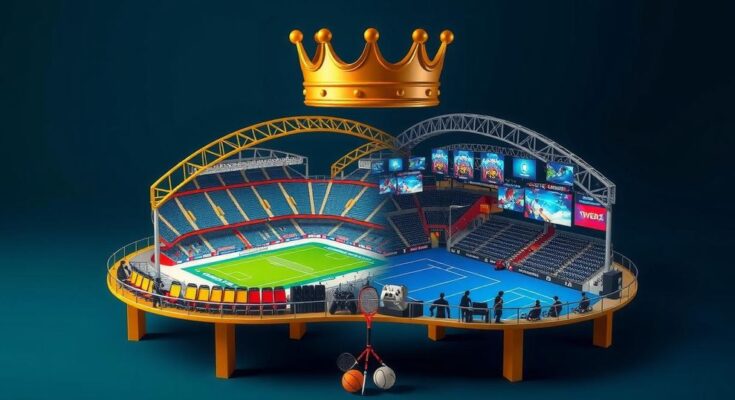Esports, represented by the League of Legends World Championship, showcases successful strategies that resonate with young audiences and sponsors. From immersive fan experiences to innovative sponsorship models, the principles at play provide valuable insights for traditional sports. Highlights include co-streaming, emotional brand engagement, and community focus, which can help traditional sports maintain relevance and captivate new fans.
The League of Legends World Championship showcased esports at its finest, featuring 24 teams competing fiercely for the prestigious Summoner’s Cup. Team DRX from South Korea emerged victorious, but the true triumph belonged to the event organizers, who sold out tickets rapidly and attracted esteemed sponsors like Amazon and Mastercard. The growing presence of traditional sponsors, such as Mercedes-Benz, highlights the increasing recognition of esports as a commercial powerhouse. With 73.9 million viewers during the 2021 finals, esports continues its march toward global prominence, especially among younger audiences. Esports has come a long way from being dismissed as mere “kids gambling in the basement.” Today, it boasts over 500 million enthusiasts worldwide, with a vibrant community around popular titles like League of Legends. Professor Andreas Bergmann emphasized the appeal of esports to the elusive 14-29 age group, who engage deeply as fans and followers. This demographic’s interest is transforming esports into a mainstream phenomenon, particularly in regions like China, Asia, Europe, and the USA. While esports captivates young audiences and fills grand venues, traditional sports struggle to evoke similar enthusiasm. The question arises: how can traditional sports adapt their events to appeal to younger fans and sponsors? Lessons from esports emphasize the importance of seeing every event as a holistic entertainment experience, infusing elements like thrilling opening ceremonies, innovative technologies, and fan-centered festivals. This multi-layered approach caters to diverse stakeholders, creating unforgettable events. High-profile collaborations, such as a musical opening featuring icons like Lil Nas X, immerse audiences in a captivating spectacle. By combining entertainment with the core sporting action through modern technologies like augmented reality, franchises can enhance viewer engagement and generate excitement. Moreover, sophisticated marketing campaigns prior to events greatly enhance visibility and community involvement, broadening the appeal of esports even further. The trend of co-streaming, where popular Twitch streamers broadcast events with commentary, has revolutionized reach and engagement, allowing new audiences to discover and appreciate esports. The League of Legends Worlds successfully tapped into various audience segments through such initiatives, underscoring the potential for traditional sports to similarly expand their fan bases. Furthermore, bringing big-name influencers to events can bridge gaps between different interests, driving ticket sales and viewership. Esports thrives on the premise of meeting fans where they are, rotating the league finals through major regions to maximize reach and attendance. This principle echoes in traditional sports, with successful international events demonstrating the viability of exploratory approaches to engaging fans. The German NFL game in Munich and past events in the UK reflect the significant potential for harnessing local and international interest in stadium competitions. Sponsorship in esports transcends traditional methods, focusing on emotional connectivity with fans. By crafting authentic experiences around their brands, sponsors create lasting affinity among consumers. Unlike conventional sports that often rely on passive brand exposure, esports capitalizes on interactive and creative sponsorship activations, thus elevating the value of partnerships. Innovative sponsorship campaigns offer tailored experiences related to the game, and sponsor booths at large events attract fans to participate actively. This backstage integration creates memorable moments, enriching the spectator experience. Moreover, channels such as Twitch and YouTube offer interactive features like chat options and game-related rewards that make viewers feel invested in the action. These strategies enhance engagement and retention among GenZ viewers, transforming spectators into active participants in the esports experience. Implementing similar mechanisms in traditional sports could rejuvenate viewership and captivate younger fans yearning for interaction, igniting the same fervor that drives esports success. Ultimately, esports provides valuable lessons that traditional sports can adapt to their unique contexts for greater relevance. Bergmann encourages sports executives to embrace bold, tailored ideas rather than mimicking esports outright. The path forward is illuminated by understanding the diverse preferences of various target groups to ensure both enduring connections and brand partnerships that resonate meaningfully. Harnessing these essential strategies could unlock new potentials in traditional sports, allowing them to build vibrant communities and exciting events in the future.
The rise of esports has transformed the landscape of competitive entertainment, particularly through its innovative approaches to event management, audience engagement, and sponsorship. Traditional sports organizations can draw lessons from esports successes in capturing fan interest, especially among younger demographics. This fresh perspective allows traditional sports to rethink their strategies in lieu of changing consumer behaviors and the evolving entertainment industry.
The key takeaways from the explosive success of esports—like creating immersive experiences, engaging fan participation, and leveraging innovative sponsorship—serve as a playbook for traditional sports. By adapting these lessons to fit their unique circumstances, traditional sports can kindle greater interest and relevancy among new generations of fans and stakeholders, paving the way for a vibrant future.
Original Source: www.ispo.com



